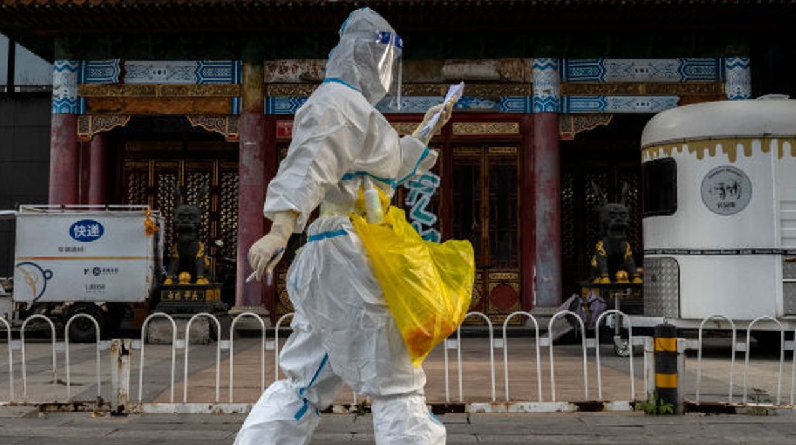The Zero-COVID Accounting in China

Earlier this month, people in a number of Chinese cities demonstrated against the government’s harsh zero-COVID policy. While the risks of openly defying such a powerful and brutal regime are high, some Chinese citizens have made the unprecedented demand that the Chinese Communist Party (CCP) and its leader, Xi Jinping, step down. The demonstrations were quickly put to rest, but the CCP’s troubles are just getting started.
In response to public pressure, the government reversed course significantly in its handling of the pandemic. For nearly three years, the government has promoted zero-COVID as superior to the approaches of other countries and vowed never to “lie flat” and let the virus run its course. The unexpected conclusion of zero-COVID has unleashed a Pandora’s box that may prove to be Xi’s greatest professional challenge.
Ditching the Concept of Zero-Concentration Viral Infection
In order to avoid disaster, it was essential to change course away from a zero-COVID strategy. As a result of the Omicron variants’ high infectiousness, the policy could no longer be maintained. Both citizens and government officials were taken aback by the policy’s sudden termination. In what seemed like an instant, references to “dynamic clearing,” the government’s preferred term for zero-COVID, were removed from policy speeches. Some high-ranking officials have begun to liken the current outbreak to the common cold. Negative nucleic acid tests are no longer required prior to using public transportation, and authorities now allow people with mild cases to isolate at home rather than herding them into makeshift hospitals.
It is unclear how much influence the protests had on the decision to abandon zero-COVID. They contributed, for sure, but more likely they just sped up a change that was already under way. It’s possible that no one outside of Beijing’s inner sanctum of power will ever know the inner workings of the decision-making process. Is Beijing’s hasty about-face solely attributable to the shock caused by the protests, or is this a rare example of Xi being overridden by his colleagues in the Politburo Standing Committee, all of whom are his allies but may not agree with him on policy matters? Or perhaps China’s current infection rate spike had simply exceeded the country’s capacity, rendering zero-COVID impossible to maintain.
Before the protests, Beijing showed signs of wanting to find a diplomatic way to end zero-COVID. The government has known for months that maintaining this policy in the Omicron era will have severe economic and social consequences. The effect on the economies of already-struggling state and local governments has been particularly worrisome. Beijing may have been concerned that the country’s strategic position at the centre of global supply chains would be jeopardised by the ongoing disruptions to Chinese businesses.
A group of officials reportedly discussed lifting the pandemic restrictions with public health experts from Hong Kong in early November, as reported by the Financial Times. Twenty government initiatives were released on November 11 to mitigate the effects of zero-COVID. The plan probably involved gradually easing regulations until the time was right to declare victory and proceed methodically. This adjustment was made with the best of intentions, but it has caused even more havoc as the infection rate has skyrocketed and local authorities have been under constant pressure to keep the number of reported cases low.
What’s at Stake for China

People outside of China have a hard time imagining the consequences of abandoning zero-COVID. China has not had the medical resources to deal with the hospitalisation rates seen in other countries, which is one reason the country has clung to the policy despite the economic and social costs. China has a high overall vaccination rate, but its domestically produced vaccines are believed to be less effective than those used in the West, and its elderly population is dangerously undervaccinated.
Beijing had a lot of time to fix these problems before the reopening was scheduled. By April of 2020, the outbreak was under control, and the number of new infections has been kept to a minimum for the past nearly two years. However, Beijing did not use the lull in the zero-COVID campaign to shore up its healthcare infrastructure. Therefore, China is just as unprepared for a wave of hospitalisations three years after the initial outbreak as it was in January 2020. The CCP has made a huge mistake by not taking action when it had the chance.
In addition, the CCP had staked a lot of its and Xi’s legitimacy on containing the virus by 2020. The initial outbreak in Wuhan was covered up, which has caused the CCP’s legitimacy to plummet to its lowest point since the Tiananmen Square massacre in 1989. The Party then committed its full resources to eliminating the infection. Within two months, normalcy had been restored to most of the country; public outrage had given way to jubilation; and an intensive propaganda campaign contrasting China’s success at containing the virus with the high infection and death rates in most of the world gave Xi and the Party more public support than ever.
However, this victory was not achieved without considerable sacrifice. Xi and the Party’s credibility were dependent on outcomes that would deteriorate if Omicron were to escape. Moreover, most Chinese people’s fear of COVID persists three years after the zero-COVID narrative was introduced. Reports from the ground suggest that many citizens are discouraged by the apparent lack of appreciation for their efforts over the past few years. As the number of infections, hospitals, and fatalities rises, it is likely that these attitudes will spread even further. The consequences of a chaotic phase-out of zero-COVID would likely be even more severe than the crisis of 2020.
An impending crisis in Xi’s legitimacy appears to be on the horizon. The worst outbreaks ever in Beijing and other cities occurred just as zero-COVID was relaxed. Due to low testing rates, the true prevalence of infections is unknown. Residents of Beijing either stay indoors because they have COVID-19 or for fear of contracting the virus. Most shops and businesses have closed today because their employees are sick at home.
According to reliable reports, a large number of healthcare workers have been infected, and hospitals are rapidly reaching capacity, just like they did during previous outbreaks in other countries. Unverified social media reports suggest that Beijing’s mortuaries and crematoriums are both at capacity, suggesting that the death toll is likely higher than has been reported so far. Some forecasting models predict over a million deaths in the coming months, and government advisors are warning that as many as 840 million people could be infected. If the public health situation continues to worsen, tensions in the community could rise to the same levels as they did last month and even escalate further.
The Future of the Party
However, Xi or the Party would not have abruptly ended zero-COVID if they did not think these risks could be managed. The coming weeks and months will likely be the most challenging of Xi’s career, but he is well positioned to succeed despite this. It’s highly unlikely that Xi will face a serious challenge to his power because his proteges control all the levers of the CCP’s power structure. To add insult to injury, he has nearly five years to recover even if the worst-case scenarios surrounding the next CCP leadership reshuffle come to fruition.
Furthermore, while most had anticipated Beijing to seek a gradual, orderly transition from zero-COVID, radical deviations from failing policies are more common in China than many realise, and they tend not to affect the standing of the paramount leader. After his “Great Leap Forward” caused the worst man-made famine in recorded history, resulting in the deaths of tens of millions of people, Mao Zedong remained China’s undisputed leader for decades. Xi lived through the disastrous 2020 attempt to hide the COVID-19 outbreak in Wuhan. He was able to come out of it even stronger than before.
See Also: The Future of Sustainable Fashion and Textiles Lies in On-Demand Production
Lastly, the CCP’s control of information inside China and its ability to use propaganda to its advantage should not be undervalued. To ensure that the zero-COVID wind-down is received favourably by the public, Xi’s proteges will continue to control the propaganda apparatus in 2020. If they succeed, the majority of Chinese citizens will believe that zero-COVID helped the country survive the worst of the pandemic unscathed and that the government returned personal freedoms as soon as the data indicated it was safe to do so. State-controlled media will argue persuasively that the situation would have been much worse if not for Xi’s leadership, regardless of how many people ultimately lose their lives to the virus.
This is not going to be an easy task for Xi and the CCP. Not all governments survived the pandemic unscathed, and China’s abrupt reversal of its most important propaganda narrative of the past three years is bound to be met with some resistance. It’s safe to say this is the toughest test of Xi’s leadership to date. It’s likely he’ll prevail, as he did in 2020, but the coming months are still uncertain.
Leave a reply
You must be logged in to post a comment.









